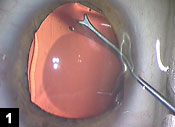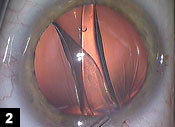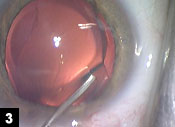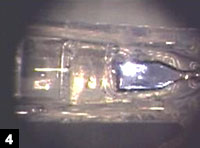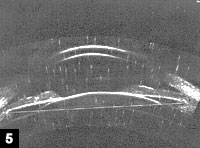Visian ICL introduced to U.S. surgeons
A clinical investigator of the phakic IOL gives tips for successful surgery.
 David C. Brown |
The STAAR Visian ICL became available to U.S. surgeons early this year. Since its approval by the Food and Drug Administration in December 2005, we have been able to offer it to patients in the range of –3 D to –16 D for correction of myopia and from –16 D to –20 D for the reduction of myopia with 2.5 D or less of astigmatism.
The outcomes of all of our early patients have been excellent, with their postop uncorrected visual acuity meeting or exceeding preop best corrected visual acuity, with a range of –4.5 D to –16 D ICLs implanted.
The results are so gratifying, it is likely that this posterior chamber phakic IOL will be an invaluable and much appreciated advance in refractive surgery, offering a wide range of myopia correction and, hopefully soon, myopia and astigmatism correction.
The implantation technique is simple and requires minimal additional instrumentation for the ASC equipped for anterior segment surgery.
Preop
ICL selection is based on keratometry with a carefully calibrated Bausch & Lomb keratometer and axial length with the Carl Zeiss Meditec IOLMaster. White-to-white distance is obtained with the B&L Orbscan and the Artemis II ultrasonic biometer. The Artemis II gives an accurate image of the diameter of the ciliary sulcus and anterior chamber depth. Conflicting data of the white-to-white distance is biased toward the ultrasonic measurements obtained with the Artemis II because it provides an actual view of the ciliary sulcus (Figure 1).
Lens power and sizing are important for optimal results, and an anterior chamber depth of more than 3 mm is an FDA requirement. Also, endothelial cell counts have been mandated by the FDA, both preop and postop.
One to two weeks before implantation of the ICL, YAG laser peripheral iridotomies are performed. It is important to make sure that these iridotomies are competent and placed 90° apart so that in the unlikely event the ICL rotates, one iridotomy will always function. The diameter of these should be 0.5 mm, and they must penetrate through the stromal and pigment epithelium of the iris.
Preoperatively, patients are instructed to use Vigamox (moxifloxacin HCl ophthalmic solution 0.5%, Alcon) drops three times a day, beginning 2 days before their surgery. Postoperatively, patients instill Vigamox three times a day for 1 week and Econopred (prednisolone acetate, Alcon) three times a day for 1 week; both drops are then discontinued.
|
|
|
Images: Brown DC |
Surgical technique
The pupil is widely dilated before surgery. Two 1.4 mm side-port incisions are made in clear cornea at 12 o’clock and 6 o’clock. Ocucoat (hydroxypropyl methylcellulose, B&L) is instilled in one of the side-port incisions to deepen the anterior chamber. A 2.5-mm diamond keratome incision is placed in clear cornea temporally. Additional Ocucoat is instilled until the anterior chamber is deep.
The ICL is injected through the 2.5-mm corneal incision and slowly unfolded in the anterior chamber (Figure 2). Care is taken to see that the orientation mark is upper right and bottom left on the lens haptic.
The lens haptics are positioned under the iris by sliding the ICL with no downward pressure on the patient’s crystalline lens (Figure 3). The nasal or temporal haptics can be positioned in either order, depending on the surgeon’s choice (Figure 4).
The optic is thin, so absolutely no touch is permitted on the optic, thus avoiding trauma to the crystalline lens.
STAAR has developed a lens loading procedure, which incorporates its MicroSTAAR injection system and a microforceps instrument developed by MicroSurgical Technology, that helps position the ICL in the cartridge (Figure 5). The lens is then easily injected with the proper anterior posterior orientation.
After positioning of the ICL, Ocucoat is irrigated from the anterior chamber by a combination of irrigating cannula and aspirating cannula, similar to the bimanual cataract extraction irrigation and aspiration technique. Once Ocucoat is evacuated from the eye, Miochol (acetylcholine chloride, Novartis Ophthalmics) is instilled. As the pupil contracts, another visual check of each laser iridotomy is made to be sure they are patent. In most cases, a small stream of Miochol is run through the iridotomy to be sure that it is open and not blocked by the Ocucoat.
|
|
|
Postoperative
The lens implant procedure may be done on separate days or the same day. On same-day surgeries, the first eye is implanted, the patient returns to the preoperative area, the operating room and instruments are turned over, and the second ICL surgery is performed. After implantation, IOP is measured and the patient is seen the next morning for assessment.
At 1 week, the eyes are healed and require no more treatment. Follow-up at 1 month is performed to ensure that the eyes are stabilized and the pressure is normal, and endothelial cell counts are scheduled.
Postoperative ICL patients are stable with no complaints of fluctuating vision or dry eyes, and they resume full activity within day after the procedure.
For more information:
- David C. Brown, MD, FACS, ABES, is the president and medical director of Eye Centers of Florida. He can be reached at 4101 Evans Ave., Fort Myers, FL 33901; 239-939-3456; fax: 239-939-1575; e-mail: david.brown@ecof.com. Dr. Brown has no direct financial interest in the products mentioned in this article, nor is he a paid consultant for any companies mentioned.
- STAAR Surgical, maker of the Visian ICL, can be reached at 1911 Walker Ave., Monrovia, CA 91016; 626-303-7902; fax: 626-359-8402; Web site: www.staar.com.

